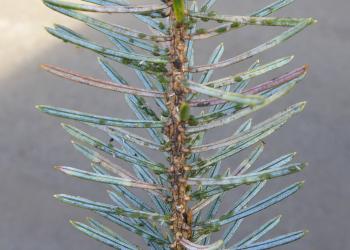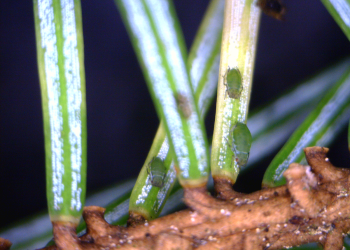Spruce Aphid
Elatobium abietinum Walker
Host(s) in Alaska: Spruce species, especially Sitka spruce (Picea sitchensis).
Habitat(s): Spruce needles.
General Distribution in Alaska: Established throughout Southeast Alaska and Prince William Sound and parts of the Kenai Peninsula and Kodiak Island.
Current Status & Distribution in Alaska (2024)
Spruce aphid activity was very low throughout the state.
Ground Detection Survey Observations: 1 Sitka spruce tree with moderate damage was recorded in a permanent ground survey plot in Sitka.
iNaturalist Observations: None.
Historic Activity
Spruce aphid damage was low in 2019, with less than 100 acres recorded during aerial survey. Spruce aphid activity drastically decreased throughout Southeast and the Kenai Peninsula in 2017 after the cold winter of 2016/2017. Damage continues to persist between Craig and Klawock on Prince of Wales Island, Sitka, Thomas Bay, and on Douglas and Shelter Islands near Juneau. Additionally, three small pockets of spruce aphid activity were observed in the Kodiak Archipelago (26 acres), two on the Kupreanof Peninsula of Kodiak Island, and one near Onion Bay on Raspberry Island. Spruce aphid damage was not recorded on the Kenai Peninsula in 2019. In October ground surveys on the Kenai Peninsula, we detected very light spruce aphid activity in six locations around Homer (up from only two locations in May) and heavy spruce aphid damage near the Homer library. An area of spruce defoliation was observed on Annette Island in Southeast Alaska (57 acres), however the damage agent may have been spruce aphid or hemlock sawfly, which is currently in outbreak and has been found feeding on spruce in some areas. The last year with pronounced spruce aphid damage was 2016, when 34,200 acres were mapped.
Spruce aphids are native to Europe where they naturally occur on white spruce (Picea glauca). It first became a notable pest after Sitka spruce was planted in maritime countries of Europe. It was likely transported to the Pacific Northwest on nursery stock and was found in Wrangell in 1927. The first notable outbreak of spruce aphid in Alaska was in 1967 when it was found injuring ornamental spruce in Sitka. It has since been a reoccurring pest of Sitka spruce throughout Southeast Alaska, with damage mostly limited to coastal and urban forests. In general, heavy aphid damage is restricted to these areas; however it can be found extending up to 800 feet in elevation in locations with direct sun exposure. This creates a warmer and therefore more conducive winter climate for aphid survival. Spruce aphid outbreaks are usually preceded by mild winters and normally last two or three years before the population crashes.
Recently, spruce aphid populations have been detected in parts of Southcentral Alaska. On the Kenai Peninsula, outbreak conditions were first noted around Kachemak Bay in 2015, primarily in Homer and Halibut Cove. As of October 2016, aphid populations have been detected in several locations on the Kenai Peninsula and Kodiak Archipelago.
The spruce aphid is a non-native pest of Sitka spruce that causes severe needle drop and decreases growth and vigor of the tree. Spruce aphids derive nutrition from spruce trees by piercing the foliage and sucking the sap from the older needles. Infestations begin in shaded portions of the lower crown but can move into the leader and upper crown during outbreaks. Older needles are preferred because new growth does not become nutritionally adequate until it has gone through winter dormancy. The first symptoms of feeding are yellow patches on the needles and are sometimes accompanied by a black fungal growth that looks like soot. Feeding damage intensifies as the populations rise and affected needles turn brown and drop prematurely, leaving only the tips of the new growth unaffected. Needle drop can be drastic during outbreaks and often garners attention from the public. Tree vigor and growth is a reduced as a result of aphid feeding; however, it is rare for trees to be killed outright. Aphid outbreaks are usually limited to spruce growing along beach fringes or near the water, although on occasion inland trees will be attacked and defoliated.
Spruce aphids reproduce through parthenogenesis, which is an asexual method of reproduction without fertilization. To our knowledge, the population of spruce aphids in Alaska consists entirely of females but male aphids occur in parts of the European distribution. The adult females give birth to live young which mature in ~2 to 3 weeks. Under ideal conditions, this reproductive strategy allows for aphid populations to increase over a relatively short amount of time. Aphids can feed throughout the winter if temperatures remain above freezing; populations begin to rise in late winter/early spring and continue to increase until early summer. By midsummer populations reach a low point or may disappear entirely. This decline in aphid numbers is due to numerous factors including migration by winged females, increased predation and parasitism, and changes in the chemistry of the spruce needles. Populations can rise again in the fall if the weather is mild, resulting in significant defoliation . Winter temperatures have a direct effect on aphid populations; consistent temperatures below freezing prevent aphid feeding, and extreme cold can kill the aphids outright.
Sitka spruce growing along the coast and in stressful environments, such as urban areas, are the most susceptible to aphid damage. It is important to ensure that trees in those situations have the best possible growing conditions. Care should be taken to avoid injuring the roots, either mechanically or through soil compaction. Soil should neither be placed on top of nor removed from the area beneath the crown of the tree. In order to avoid moisture stress, adequate water should be provided to the trees throughout the growing season. Spring fertilization also helps to promote tree vigor and to minimize the effect that defoliators such as aphids might have on a tree. The UAF Cooperative Extension Service should be consulted for specific information on the type and amount of fertilizer to be applied.
Normally, harsh winter weather is the most important natural control for spruce aphids. In years when the winter is mild, homeowners should expect aphid damage to occur and must recognize the importance of early detection of the insects. Aphids build up before damage is noted, and in order to be effective, controls should be carried out before extensive defoliation has occurred. This requires careful periodic examination of the needles, beginning in February after a mild winter.
Aphids first appear on shaded portions of the lower crown and are easiest to control at this early stage.
When aphids are found, several control options are available:
- A high-pressure water spray will dislodge many aphids from the needles but will need to be repeated fairly frequently during the season.
- Commercial insecticides are available and effective against aphids. Azadirachtin acephate, cyfluthrin, horticultural oils, and imidacloprid are some of the active ingredients that can be used on ornamental trees for the control of spruce aphid. Application methods vary for different products and can include sprays, soil drenches, or stem injections. Some products may discolor needles or need to be applied repeatedly. Please read and follow all label directions carefully. Remember, the label is the law!
Check with your local Cooperative Extension Service office for insecticides that are currently registered for control of spruce aphids.
Coastal Alaska Spruce Aphid Monitoring Video
This short video (4 min) is intended for high school students in coastal Alaska that are interested in helping the U.S. Forest Service Monitor for spruce aphid through their schools. The associated datasheet for this activity can be downloaded here. We appreciate your help monitoring for this established invasive insect in our coastal forests!
Schultz, ME. CJ Fettig, RR Borys, and RE Burnside. 2009. Evaluation of Systemic Insecticides for Control of Elatobium abietinum (Homoptera: Aphididae) on Picea sitchensis in Southeast Alaska. J. Entomol. Sci. 44:78-84.
For more information, contact Dr. Elizabeth Graham, Entomologist, U.S. Forest Service, at elizabeth.e.graham@usda.gov.







